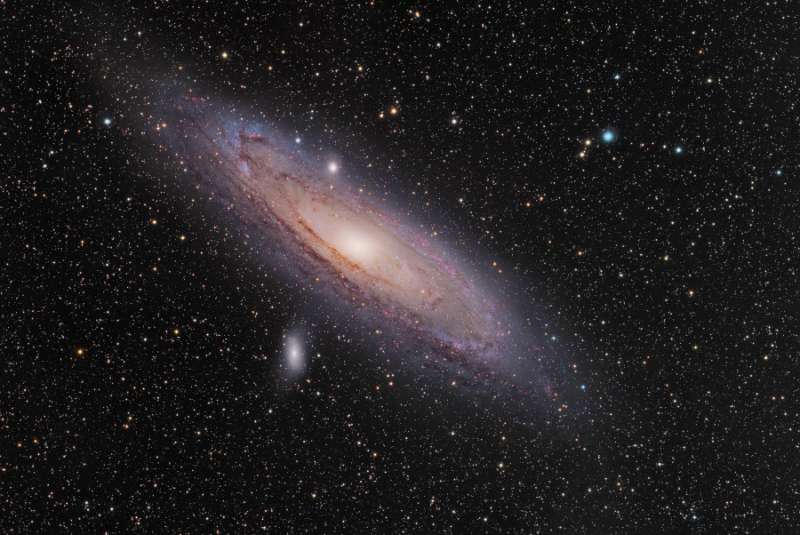Credit & Copyright: Martin Pugh
Explanation:
The most distant object easily visible to the eye is
M31,
the great
Andromeda Galaxy
some two and a half million light-years away.
But without a telescope, even this
immense spiral galaxy - spanning over
200,000 light years - appears as a faint, nebulous cloud in the
constellation
Andromeda.
In contrast, details of a bright yellow nucleus and dark winding dust lanes,
are revealed in this
digital telescopic image.
Narrow band image data, recording emission from hydrogen atoms, shows off
the reddish star-forming regions dotting
gorgeous blue spiral arms and young star clusters
While even casual
skygazers
are now inspired by the knowledge that there are
many distant galaxies like M31, astronomers
seriously debated
this fundamental concept in the 20th century.
Were these "spiral nebulae" simply outlying components of our own
Milky Way Galaxy or were they instead "island universes" -- distant
systems of stars comparable to the Milky Way itself?
This question was central to the famous
Shapley-Curtis
debate
of 1920, which was later resolved by
observations of M31
in favor of Andromeda,
island universe.
Note:
An APOD editor will review great space images on Thursday, January 14, in
Houghton, Michigan.
digg_url = 'http://apod.nasa.gov/apod/ap100109.html'; digg_skin = 'compact';
1999 2000 2001 2002 2003 2004 2005 2006 2007 2008 2009 2010 2011 2012 2013 2014 2015 2016 2017 2018 2019 2020 2021 2022 2023 2024 2025 |
Yanvar' Fevral' Mart Aprel' Mai Iyun' Iyul' Avgust Sentyabr' Oktyabr' Noyabr' Dekabr' |
NASA Web Site Statements, Warnings, and Disclaimers
NASA Official: Jay Norris. Specific rights apply.
A service of: LHEA at NASA / GSFC
& Michigan Tech. U.
|
Publikacii s klyuchevymi slovami:
spiral galaxy - M 31 - galaktika, spiral'naya - Andromeda - Tumannost' Andromedy
Publikacii so slovami: spiral galaxy - M 31 - galaktika, spiral'naya - Andromeda - Tumannost' Andromedy | |
Sm. takzhe:
Vse publikacii na tu zhe temu >> | |
